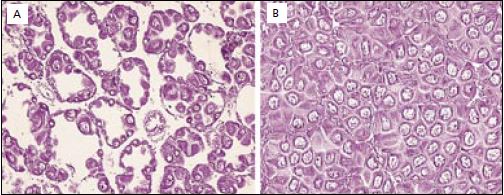2.2 LIFE HISTORY
2.2.1 Gonadal development and spawning
In most bivalves sexual maturity is dependent on size rather than age and size at sexual maturity depends on species and geographic distribution. Production of eggs and sperm is termed gametogenesis and size of the bivalve along with temperature and quantity and quality of food are undoubtedly important in initiating this process. The gonad is composed of many-branched, ciliated ducts from which numerous sacs, termed follicles, open.
Gametes arise by proliferation of germinal cells that line the follicle wall. The gonad undergoes continuous development until it becomes fully mature but this development has been divided into several stages for convenience, e.g. resting, developing, mature, partially spawned and spawned. When the gonads or gonadal tissue are fully mature they are very evident and form a significant portion of the soft parts of the animal. Gonaducts that will carry the gametes to the body chamber develop, enlarge and are readily observed in the gonad. At this time the animal is frequently referred to as being ripe.

Figure 10: Photomicrographs of histological sections through the ovary of the scallop, Argopecten gibbus, during gametogenesis. To the left (A), developing eggs can be seen lining the walls of the numerous follicles. The right hand photograph (B) shows the follicles filled with mature eggs (courtesy: Cyr Couturier and Samia Sarkis).
Several methods have been used to determine if a bivalve is ripe and ready to spawn. The most accurate method is to make histological slides of the gonad (Figure 10) but this is costly, time consuming and the animal must be sacrificed. Making smears of the gonad or extracting small samples of the gonad from a few individuals of a stock and examining them microscopically is an alternative and the most frequently used technique. In scallops, the gonadal index (weight of the gonad divided by the weight of the soft parts, multiplied by 100) is sometimes used. A rigid routine is generally followed in hatcheries to condition adults for spawning and with practice, most hatchery managers quickly develop the ability to know if the animal is ripe and ready to spawn by examining the gonad macroscopically.
Bivalves that reach the size of sexual maturity and spawn for the first time are sometimes referred to as virgins. Although these animals attain sexual maturity, the number of gametes produced is limited and sometimes not all are viable. During subsequent spawning the number of gametes produced greatly increases.
The period of spawning in natural populations differs with species and geographic location. Spawning may be triggered by several environmental factors including temperature, chemical and physical stimuli, water currents or a combination of these and other factors. The presence of sperm in the water will frequently trigger spawning in other animals of the same species. Some bivalve species in tropical environments have mature gametes throughout the year and limited spawning may occur continuously during the year. In temperate areas, spawning is usually confined to a particular time of the year. Many bivalves undergo mass spawning and the period of spawning may be brief. Virtually the entire contents of the gonad are released over a short period during spawning activity. Other species of bivalves have a protracted spawning period and it may extend over a period of weeks. These species are sometimes referred to as dribble spawners. Limited spawning occurs over a protracted period with one or two major pulses during this time. In some species there may be more than one distinct spawning in a year. In hermaphroditic species, spawning is timed so that either the male or female part of the gonad spawns first. This minimizes the possibility of self-fertilization.
In most bivalve species of commercial interest, gametes are discharged into the open environment where fertilization occurs. Sperm is discharged in a thin, steady stream through the exhalent opening or exhalent siphon. Discharge of eggs is more intermittent and they are emitted in clouds from the exhalent opening or siphon. In species such as scallops or oysters, females frequently clap the valves to expel the eggs. This may be done to clear eggs lodged on the gills. After spawning the gonads of many species are emptied and it is impossible to macroscopically distinguish sex in individuals. The animal is then said to be in the resting stage. In dribble spawners, the gonad may never be completely emptied.
Some bivalves, e.g. the European flat oyster, are larviporous and the early stages of larval development occur in the inhalant chamber of the mantle cavity of the female phase oyster. Eggs when spawned are passed through the gills and are retained in the mantle chamber. Sperm is taken in through the inhalant opening. The length of time larvae are held in the mantle chamber and subsequently the length of time larvae are free living in surface waters varies with species. In some genera, e.g. Tiostrea, larvae may only be part of the plankton for as little as one day.
Occasionally, particularly in temperate areas, spawning may not occur in some years. This can be a consequence of several factors but probably mostly is related to water temperatures, which remain too low to trigger spawning. When this occurs in oysters, the eggs and sperm may be reabsorbed into the gonadal tissue, broken down and stored as glycogen. In clams and scallops the gonad may remain in a ripe condition until the next year.